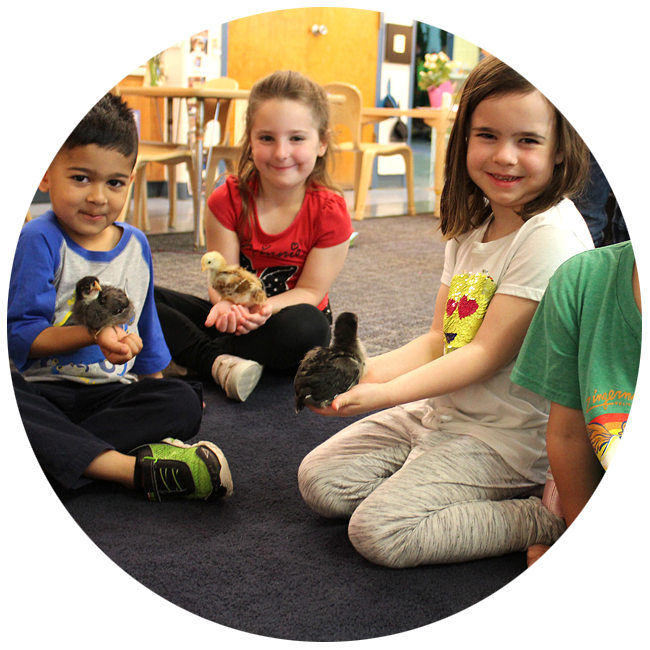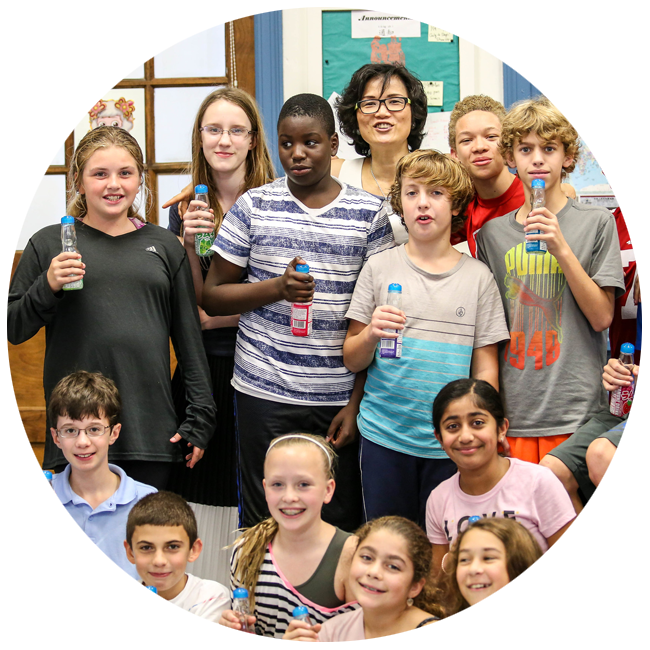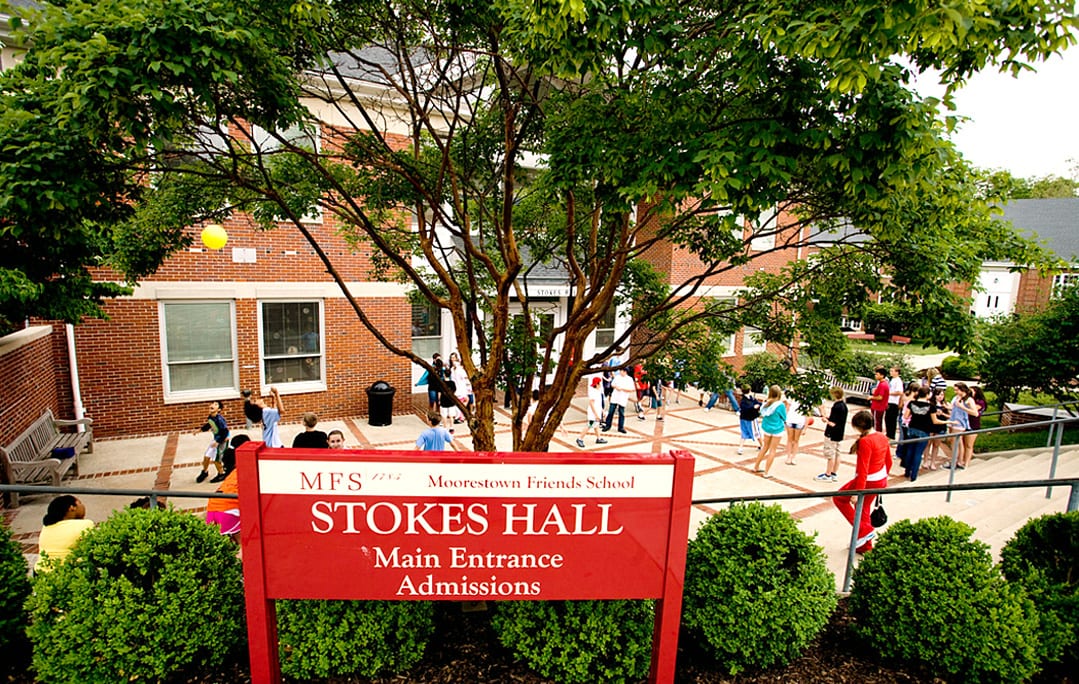The Playscape
The Playscape is a product of a year-long design process that included students, teachers, and families. The goal was to create a natural play space with opportunities for open-ended play that grows with students as they age. Children wanted places to perch, hide, be upside down, climb, interact with nature, be alone, and together. The Playscape achieves all of these things into one, multi-age, immersive natural environment.
The outdoor area is referred to as a Playscape instead of a playground because it’s not just about play structures and activity. The space highlights the instructional value of landscape architecture and the desire for children to engage with and learn from nature.
View Playscape Elements
Play Zone 1

Play Zone 1 features a log and net climber, pendulum swing, and slides. The log and net climber allows children of different ages and abilities to engage with the structure, gain height, gather and socialize, and challenge themselves as they age. The pendulum swing invites collaborative play where students work together to get the swing to move and accelerate to new heights. The custom-built slides include both single and community slides, so students can have choice in the types of experience they want.
Play Zone 2

In addition to the pendulum swing, six traditional swings are available for kids of all ages on Play Zone 2. It’s no surprise that children love swings. Students listed swings as the number one thing they wanted on their new Playscape.
Play Zone 3

Play Zone 3 includes another set of slides that are smaller and more accessible to younger students. A parkour set invites physical challenge and builds upper body strength and is complemented by monkey bars, which were found to be a favorite of students during the design process. Students also requested places where they could socialize and be in small groups. The hammock invites students to spend time alone or in conversation with others. It also serves as another swinging element.
Terrace 4

Older students were eager for a field space where they could play ball games, tag, and team sports. The field on Play Zone 4 invites group play and incorporates green space where there was none before on the playground.
Sandbox

Students love building things and many requested a sand feature. A large, inviting sandbox incorporates natural log elements for multi-dimensional play.
Rain Garden

A Rain Garden provides students with an up-close look at plantings and the insects and butterflies it attracts. The wood steppers allow children to walk through the garden, interact with the space, and get a “forest floor” look at nature. The hill on campus presented a stormwater management challenge. The Rain Garden is designed to collect rainwater from different zones on the Playscape and from up campus, routing it to this central space that will feed native plantings.
Playpods

Two custom-designed playpods provide spaces where students can play, hide, and be alone or in small groups. The “onion pod” provides a treehouse effect, while the “clamshell pod” provides an underground/cave-like experience.
View a Timelapse of the Playscape Construction!
Plant photography citations in video:
Acer rubrum – Red Maple Is licensed under Famartin, CC BY-SA 4.0, via Wikimedia Commons
Acer saccharum – Sugar Maple Is licensed under Famartin, CC BY-SA 4.0, via Wikimedia Commons
Cornus florida – Flowering Dogwood Is licensed under Bernard Spragg. NZ from Christchurch, New Zealand, Public domain, via Wikimedia Commons
Amelanchier arborea – Serviceberry Is licensed under Dcrjsr, CC BY 3.0, via Wikimedia Commons
Cornus alba “Bailhalo” – Ivory Halo Dogwood Is licensed under Photo by David J. Stang, CC BY-SA 4.0, via Wikimedia Commons
Cornus sericea – Red-osier Dogwood Is licensed under Sulfur at the English-language Wikipedia, CC BY-SA 3.0, via Wikimedia Commons
Hydrangea quercifolia – Oakleaf Hydrangea Is licensed under Anne Norman, CC BY 2.0, via Wikimedia Commons
Ilex verticillata – Winterberry Is licensed under Photo by and (c)2016 Derek Ramsey (Ram-Man), CC BY-SA 4.0, via Wikimedia Commons
Achillea millefolium – “White” Yarrow Is licensed under Petar Milošević, CC BY-SA 4.0, via Wikimedia Commons
Allium stipitatum – “White Giant” Ornamental Onion Is licensed under I, KENPEI, CC BY-SA 3.0, via Wikimedia Commons
Deschampsia cespitosa – Tufted Hair Grass Is licensed under Christian Fischer, CC BY-SA 3.0, via Wikimedia Commons
Echinops bannaticus – “Star Frost” Globe Thistle Is licensed under Foto: Jonn Leffmann, CC BY 3.0, via Wikimedia Commons
Echinacea purpurea – Purple Coneflower Is licensed under Eric Hunt, CC BY-SA 4.0, via Wikimedia Commons
Helleborus x hybridus – Hellebore Is licensed under Wildfeuer, CC BY-SA 3.0, via Wikimedia Commons
Heuchera – “White Spires” Coral Bells Is licensed under User:Geographer, CC BY 2.5, via Wikimedia Commons
Liatris spicata – “White” Blazing Star Is licensed under I, MJJR, CC BY 2.5, via Wikimedia Commons
Monarda didyma – Red Beebalm Is licensed under Smartbyte, CC BY-SA 3.0, via Wikimedia Commons
Sporobolus heterolepis – Prairie Dropseed Is licensed under Daderot, Public domain, via Wikimedia Commons
Asclepius incarnata – Common Milkweed Is licensed under Photo by and (c)2009 Derek Ramsey (Ram-Man), GFDL 1.2, via Wikimedia Commons






